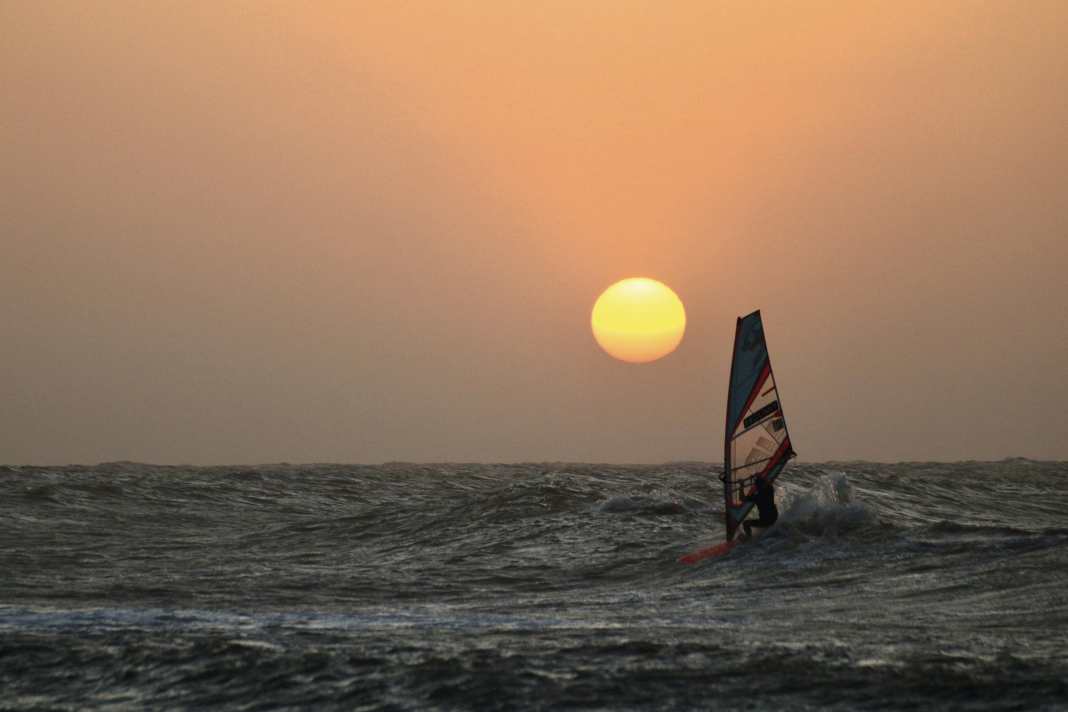





Spots in this article:
Click here for the spot description
Rostock in November: it is grey, rainy and has been cloudy for days. The world looks bleak. People huddle under their thick jackets and woolly hats. They walk against the icy wind and a nasty drizzle. The cold penetrates to the bone. From a small shop in the city centre, music reminiscent of warmth reaches my cold ears from afar. As I approach it, I notice that the café is brightly coloured. Colourful pictures of the rainforest and parrots hang on the walls. Fresh espresso is served. The steam from the coffee rises from the cup as if dancing to music. The café is like a colourful, shimmering oasis in the merciless grey of everyday life in Rostock in winter. It conveys something like joie de vivre, a certain lightness and always awakens an inexplicable longing in me.
A few days later, the phone rings. My mate Stefan is calling me from the depths of Upper Bavaria and asks what my travel plans are for this winter. He suggests flying to Colombia in February. In addition to a rainy and relatively windless Pacific coast, the country also has a Caribbean coast that is brushed by reliable trade winds between December and April. I spontaneously agree, thinking of the colourful coffee shop and looking forward to a trip into the unknown.

Contrary to my usual approach to such surf trips, I don't do much research in advance this time, but instead want to be surprised. I'm expecting gentle trade winds, which is why I'm only taking two sails and a freestyle board with me on the trip. 4.8 and 4.4 are the sails we freestylers use the most.
I would never have dreamed at that time that the 4.4 would be the only sail I would need on this holiday - and that it would be mostly overpowered. I would never have thought that Colombia had so much potential.
Arrival in Colombia
After a long journey via Amsterdam with a stopover in the Colombian capital Bogotá, we arrive at our destination: Cartagena de Indias, a city steeped in history and located on the Caribbean Sea, which brings Colombia's colonial heritage to life. As soon as you step out of the airport, you find yourself in a different world: exotic birds chirp from the tops of the palm trees, the air is warm and humid, car horns sound like a concert from everywhere. You are approached directly by people who want to help you carry your heavy boardbags. Of course, this is also about money. But after a long journey, you're simply happy for any help.
We take the hire car to our first accommodation in the centre of the city. You gather so many impressions on the way to the hostel: There are people everywhere on the streets, the bass of reggaeton music booms from every corner and the traffic is chaotic. But life is colourful and exuberant. People celebrate together on the street, without fear of contact or status.
After a short night and fortified with a Colombian breakfast and coffee, we visit Cartagena's old town in bright sunshine and calm conditions. This is because the wind in Colombia doesn't usually pick up until around midday. The sea air is refreshing, the adventure is calling. Although Cartagena is geared towards tourism, it has retained its authenticity, somewhat hidden behind the thick city walls. In my opinion, however, it is particularly important to speak a few words of Spanish in order to get on well here, to at least try to communicate in Spanish and not switch directly to this broken English, which makes all communication less charming.
You have to get involved with Colombia
As a gringo, a tourist recognisable from afar, you will be approached on every corner in Colombia. People sell everything from jewellery, clothes, food and drinks to massages and music. This can sometimes seem a little intrusive. But it's part of the cityscape and we'd rather give these people our money than spend it in soulless hotel bars. So you have to get involved with the city and show no fear of contact. Then you can enjoy Colombian hospitality and get to know the country and its people in an unfiltered way.
As we sit in the city park at Plaza de Bolívar, observing city life and immersing ourselves further and further in this fascinating Colombian world, the palm trees begin to sway noticeably in the wind. We set off in the direction of the Bocagrande peninsula, where the large, white high-rise buildings stand, reminiscent of Miami Beach and a cool contrast to the colonial style of the ochre-coloured old town buildings. We can hardly imagine how the wind can blow freely despite these gigantic buildings. But as it blows sideshore, it almost seems as if the tall buildings accelerate the wind.
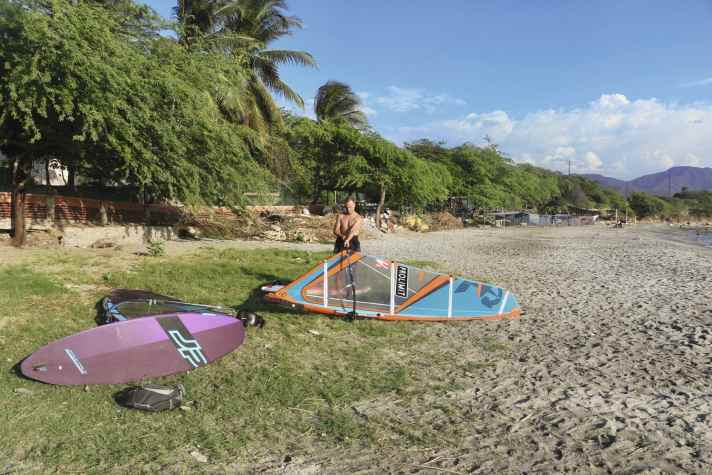
The Caribbean Sea appears choppy, slightly brownish in colour and does not shine in the turquoise blue of a postcard idyll. The waves reach a height of one to one and a half metres at the La V spot, where two large stone groynes reach into the sea in a V-shape. They always break very round. The wind is strong and blows from the right. Four to five other windsurfers join us, as well as a few wing and kite surfers. There is a small surf school down on the beach, a few people are swimming in the sea while the fishermen haul in their nets. Everything seems relaxed and harmonious. We surf into the sunset.
Dream spots in the Departamento Atlántico
After a few days in Cartagena, the journey continues towards Barranquilla. Numerous, partly undiscovered spots can be found along this stretch of coast in the Departamento Atlántico, between the two largest Colombian cities on the Caribbean Sea.
We have booked into the Kite Hostel, which is located in the immediate vicinity of the Salinas del Rey spot. Even the beach right next to our accommodation has potential. But first we decide in favour of the more frequented Salinas kite spot, where the waves are arranged on a headland and run out cleanly into a sandy bay lined with palm trees.
The spot is a dream. This is how I always imagined Jericoacoara to be: strong wind from the right, one and a half metre high but gentle waves with plenty of space between them for freestyling. Lots of kites flying over the water. We are the only windsurfers and almost a bit exotic. Construction is underway on the beach. A building complex is to be erected on the headland. The wind will then no longer be able to blow freely into the bay. As a result, this spot will probably lose a lot of its quality in the future.
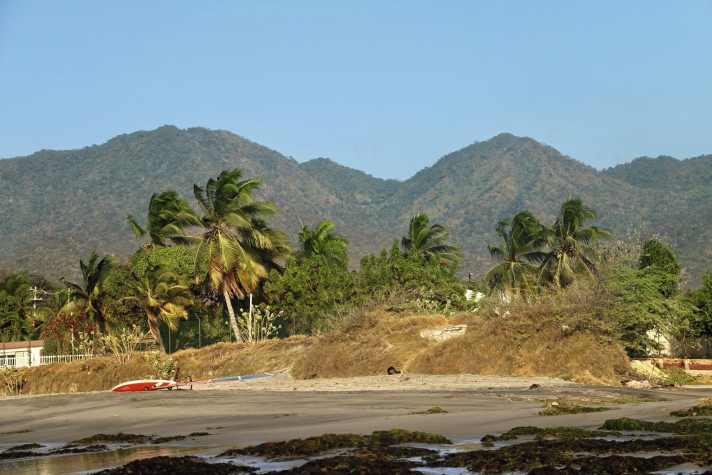
Fortunately, there are numerous alternatives. Many of the spots on the stretch of coast between Cartagena and Barranquilla are empty and partly undiscovered. There is a lot of potential here. However, the routes to the spots are adventurous. For example, there are no signposts. Map systems such as Google Maps are usually only of limited help in Colombia's chaotic road system.
In any case, we probably experienced the best wind on this stretch of coast during our trip. Because it blew relatively evenly and strongly. This was especially true for the bay of Puerto Velero, a lagoon with turquoise water that is a dream for every freestyler or freerider. Although there were numerous parasols on the beach and everything seemed to be geared towards tourism, apart from two kiters and another windsurfer, we spent most of our time here surfing alone. Puerto Velero is actually a combination spot. Because the sea side offers beautiful jumps.
Rough trip to Cabo de la Vela
After a few nice days of surfing, we head further north-east. Cabo de la Vela is our destination. The photos we saw while researching this spot were promising. But first we had to get there.
The almost 500 kilometres that had to be covered require at least a day trip. As the Colombian roads are full of surprises, I recommend taking it very easy. We bypass Barranquilla, take the modern bridge over the Río Magdalena, cross the marshland around Ciénaga and make a stop in Santa Marta to possibly go windsurfing. But the wind is offshore and gusty on all the city beaches.
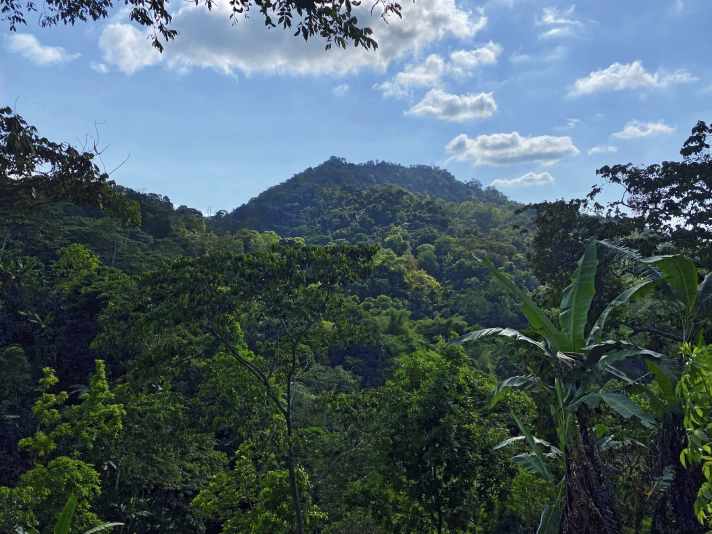
We continue in the direction of Riohacha. The weather and the landscape change. It becomes more mountainous. Clouds pile up over the green hills. The landscape looks tropical. There is no wind on the paradisiacal palm beaches. When we arrive in Riohacha, a light breeze fans our faces, but it is no invitation to go windsurfing on this urban beach. We enjoy the nightlife a little and continue our journey to Cabo de la Vela the next day.
There is only sand, cacti, wind and sea
East of Riohacha, the landscape becomes increasingly barren. Salt flats alternate with vast steppes. This is the land of the Guajira Indians. There are only a few roads - basically just one main road that runs straight through the region and divides it like a ruler. For a long time, the road, which then turns into a gravel track, leads past a never-ending railway line. Many Indian children wait at the side of the road. Some of them are begging. As we take a turn towards the sea, the condition of the road gets noticeably worse. We touch down more than once. More than once we almost get stuck. More than once, the children set up roadblocks and we can only continue with small change.
When we arrive in Cabo de la Vela after hours of bumpy driving, we see a beach with wooden huts and an offshore wind. A few kite kites can be seen in the sky. We go out and have a nice session with a rough wind, which becomes a little gentler towards the evening. We spend the night in a hotel consisting of various wooden huts. Many travellers spend the night here in hammocks, some under the open sky on the beach. What sounds idyllic and romantic can actually be torture if you are used to a bed with a real mattress.
Cabo de la Vela is generally rugged in its charm. Here there is only sand, cacti, wind and sea. The land is sacred to the Indians. They live in the wooden huts not far from the spot and offer dinner straight from the kitchen while you sit in the living room or on the terrace and serve the children.
Unknown lagoons in Colombia
As the main spot in Cabo de la Vela doesn't really convince us, we look for alternatives and start an adventure trip through the land of the Guajira Indians. It's only about 25 kilometres as the crow flies to another lagoon in the east, where the railway tracks end at the sea in Puerto Bolivar. What we experience on the sandy track on the way to a spot that isn't really a spot defies description.
The land is desert-like and vast. Time and again, wooden huts appear at the side of the road, from which the children jump as soon as they spot our car. They set up roadblocks and only let us on once we have given them some money or sweets. This becomes increasingly problematic when we run out of both change and the snacks that were actually meant for us. (There were at least 30 roadblocks.) It takes us almost three hours to cover 40 kilometres. We don't even discover a spot. The bay is surrounded almost everywhere by mangrove forests and there is simply no way to the water. It all looks very crocodile-like.
Are crocodiles lurking in the waist-deep mud?
We finally find a bay where the wind blows offshore and relatively freely out to sea, park about a kilometre and a half away from the spot to avoid sinking into the sand and cover this distance on foot. We rig up at the water's edge. We walk into the water and suddenly find ourselves up to our waists in mud. Somehow we make our way out onto the water. Everything is full of mud, the boom surface is slippery. But when everything is washed off after a few strokes, we can start to enjoy the great conditions: steady wind for the 4.4, mirror-smooth water at bathtub temperature and not a soul in sight. Every time we crash, we wonder whether a crocodile is about to snap, but somehow we seem to be the only ones for miles around. Only two fishermen watch us from a distance. There are plenty of lagoons and undiscovered spots like this in Colombia. We also windsurf at such a perfect freestyle spot near Barranquilla in the river delta of the Río Magdalena - but even in this lagoon, the slippery mud poses a real problem. At the very least, you're overpowered the whole time with the 4.4 sail.
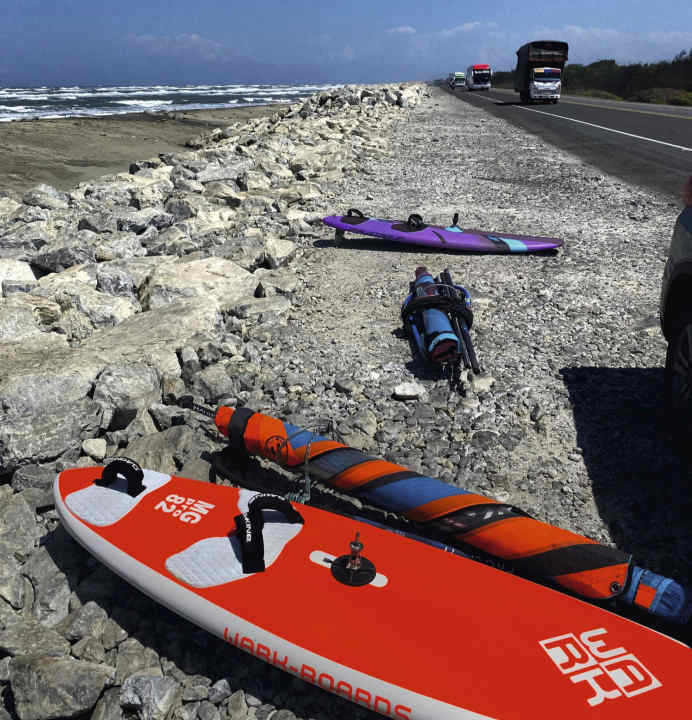
Music, joie de vivre and likeable chaos
The country has many treasures in store, not just for windsurfers. The people are friendly, the weather is good and the wind blows strongly. But it is also an adventure and not easy to find the one ideal spot where you would like to spend your whole holiday. We thought in advance that Cabo de la Vela would be such an ideal spot, but realised that the coast of the Departamento Atlántico offers the most suitable conditions for us windsurfers. At the same time, Colombia is so diverse and attractive that it would be a shame to spend the whole holiday just hanging out on the beach.
That's why you should travel the country individually and discover its secrets, at least a little. Barranquilla, Cartagena, Bogotá, Calí, Medellín - even the names of these Colombian cities sound like music. In fact, music and the constant beat of reggae seem to be an integral part of everyday life for Colombians. It sets the rhythm of life, which is characterised by a certain lightness, especially in view of the many everyday problems and challenges that Colombians are confronted with. Enjoying life in the moment and not forgetting the passion is the motto.
With God's blessing on the road
How can everyday life in Colombia be grey and monotonous when every house seems colourful and individual, when the shops on the roadside seem to drown each other out with their music? The music from the billiard parlours is so loud that sometimes even our car vibrates as we drive past. That would be unthinkable in Germany! There, the shops would have already sued each other for disturbing the peace. But here, people simply dance in front of them on the street, offering arepas and empanadas, coconuts, coffee and tropical fruit. Boredom seems to be a foreign word. The teeming, colourful diversity is almost hypnotising. If you pass through a city like Barranquilla, not a second seems to pass without you seeing, hearing or smelling something that seems crazy, exotic, funny and often reckless to us Germans.
Whole families sit on the motorbikes, usually without helmets. A policeman drives one-handed and makes a video call on the side. Exotic bird calls mingle with the honking of bright yellow taxis. Dogs run calmly across a four-lane road, people jog and barbecue on the hard shoulder. "Gracias dios por tu bendición" is written on the rear windows of the taxis. The drivers give thanks for God's blessing that protects them in the traffic of the urban jungle, like our driver Juan, who proudly tells us about his German ancestors as he drives us to a carnival parade.
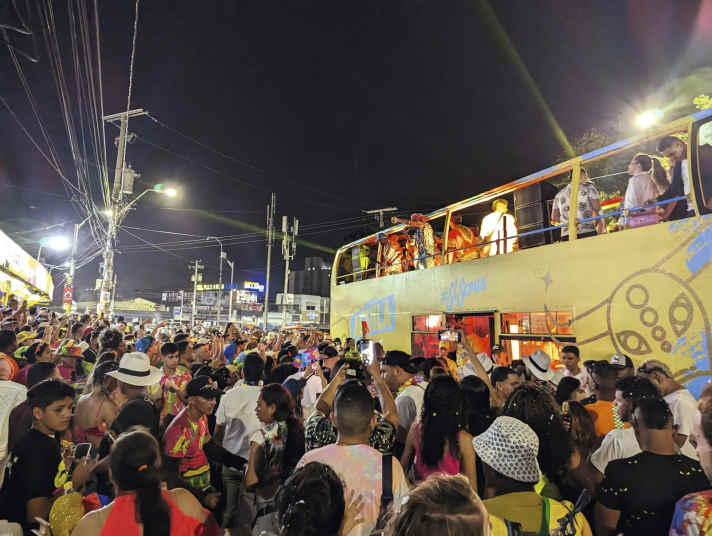
The Carnaval de Barranquilla, which we visit as part of our compulsory programme, is a UNESCO World Heritage Site. It is loud, colourful, shrill and crazy. Perhaps only reggaeton can embody this atmosphere and translate it into sound. In any case, I now listen to this music with completely different ears after my trip to Colombia.
Colombia really cast a spell over us. We would like to visit the country again and immerse ourselves further in this culture. The following spot guide is very individual. It is therefore not a one-size-fits-all recipe for a successful windsurfing trip, but only provides valuable tips and impressions. Your next trip to Colombia could look completely different and be just as successful or even more successful. It just goes to show how diverse and full of undiscovered potential the country is.
Shady sides and security in Colombia
The crime rate in Colombia is generally high, especially in the big cities as well as in scenic areas. You should be vigilant and take the necessary precautions in crowded squares and busy places. During the Barranquilla Carnival, the streets can get very crowded and it is advisable not to take any valuables with you. In addition, road traffic in Colombia can be quite dangerous. Road checks by the police
are unspectacular, however. The self-built toll booths of the indigenous population at Cabo de la Vela require some patience and negotiating skills. Here it is helpful to have small gifts such as biscuits or water ready.
The best windsurfing spots in Colombia
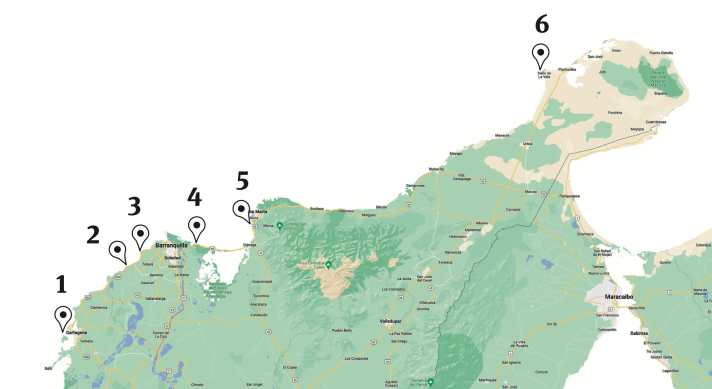
1. Cartagena "La V" - 10°23'52.3 "N 75°33'58.0 "W
On the Bocagrande peninsula, skyscrapers stand so high that you could be forgiven for thinking you were on Miami Beach. Fortunately, the wind comes from the sideshore and the huge skyscrapers even seem to accelerate the wind. The beautiful beach is interrupted in places by large stone groynes, which organise the wave somewhat, but also take away some of its power. The groynes at the "La V" spot are arranged in a V-shape and you can find gentle, clean waves downwind of them. However, the conditions are more conducive to chop, jumping and, of course, freestyling than radical wave riding. There is a small kitesurfing and windsurfing school right on the beach. This is the spot where we met the most windsurfers - five on the water at the same time was the maximum, plus a few kiters and wingsurfers.
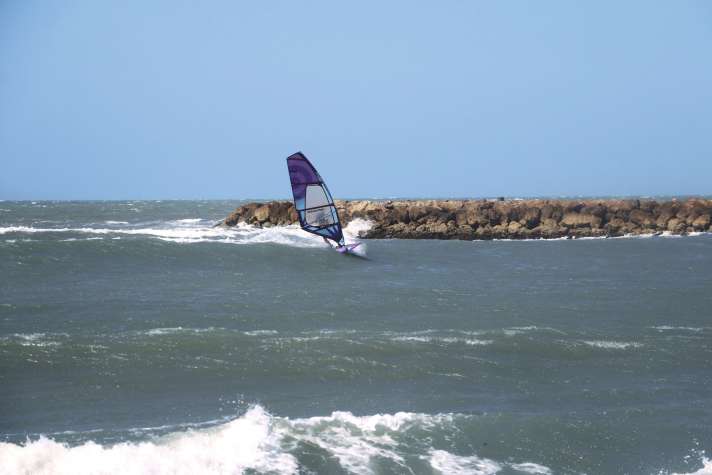
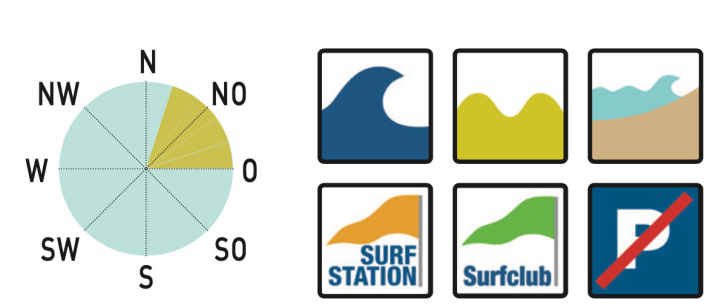
2nd Salinas del Rey "Little Jeri" - 10°52'20.0 "N 75°06'03.2 "W
The waves are organised on a flat headland surrounded by rocks. They run cleanly into a sandy bay. There is a little infrastructure at the spot with a restaurant and a small kite school. There are many umbrellas on the water and we only met one other windsurfer. The wave here is also mostly powerless, breaking most powerfully off the headland, where there are also many rocks close to the shore. You can really have fun here with a freestyle board, as the water between the waves remains super smooth. A building is being constructed right on the headland that organises the waves, so the wind in the bay will unfortunately become gusty in the future.
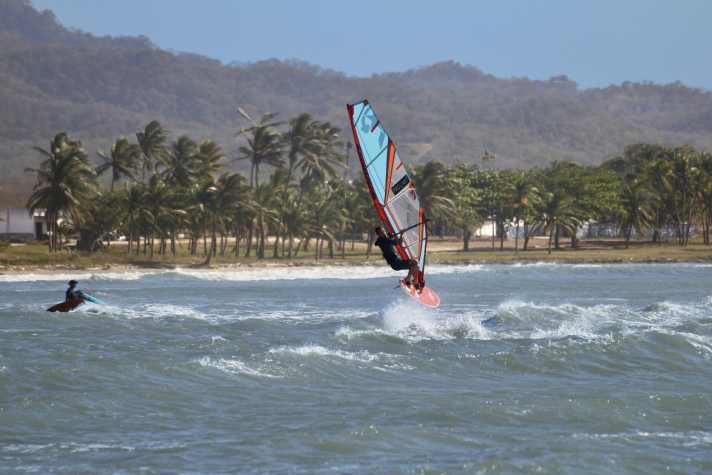
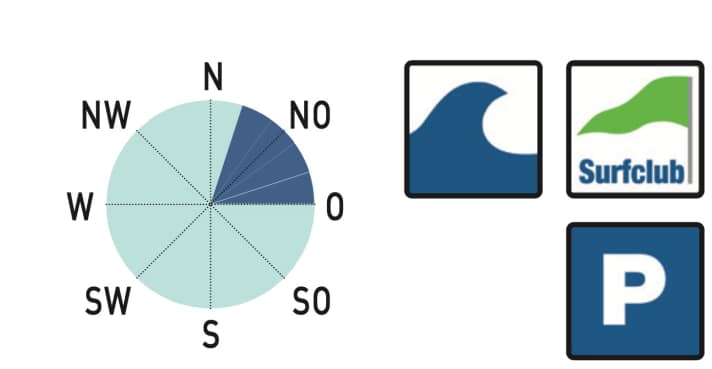
3rd Puerto Velero - 10°56'58.5 "N 75°01'57.7 "W
Imagine a bay with turquoise water, some of which is shallow and which you have all to yourself. We caught two days of super-strong wind here without seeing any other surfers. The wind blows offshore. If you start further downwind in front of the hotel complex, you have nice flat water conditions with wind from the left. There are no dangers in the water, apart from a few fishing nets, but these are marked. The wind picks up locally - pack small sails!
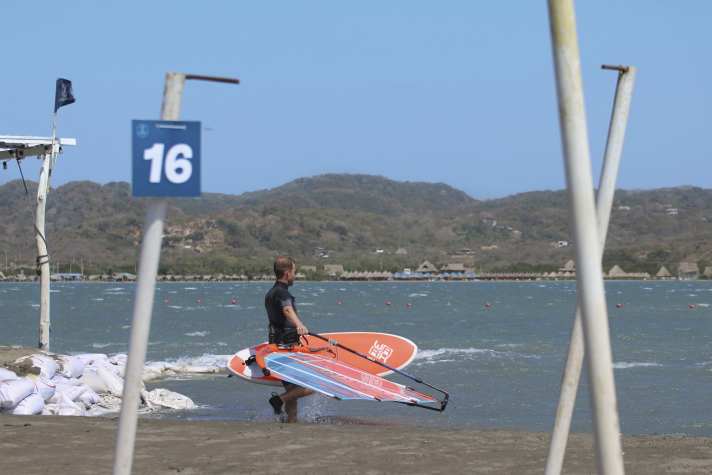
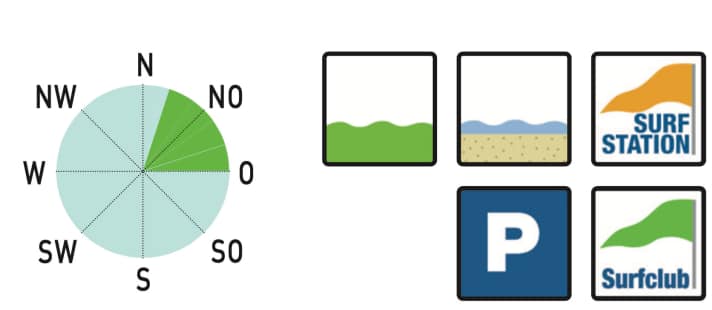
4. Salamanca (adventure spot) - 11°01'17.2 "N 74°38'32.1 "W
There are numerous lagoons, called ciénagas, in the Barranquilla area. However, it was not easy to find access points and spots here where the mangrove forests did not block the wind. However, there is beach access where the country road towards Santa Marta meets the sea. You park on the hard shoulder while the heavy lorries roar past a few metres further on. The conditions on the water are just as fierce. The trade wind was blowing almost completely onshore with a solid force six.
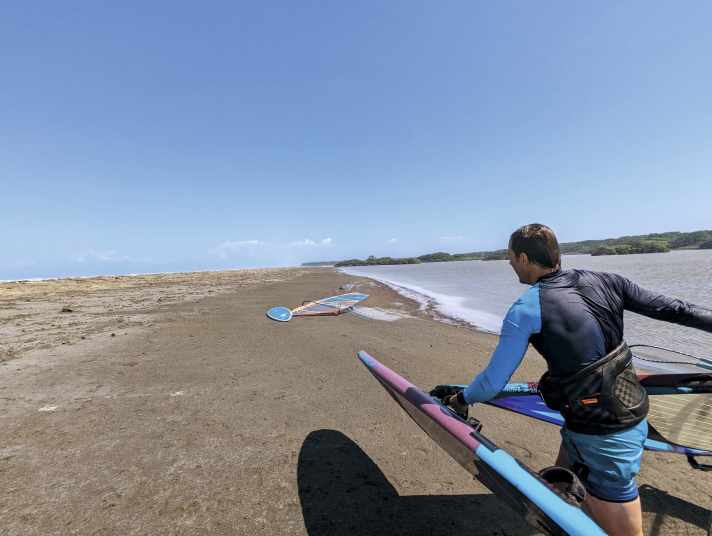
We decided to discover a lagoon that lies directly behind the sea. However, reaching it was a real adventure: we fought our way through the onshore surf parallel to the beach. After about three kilometres to the east, we reached the lagoon. Brown water, as smooth as glass, the wind blowing freely across the beach from the sea and then offshore onto the lagoon - basically perfect. Despite what felt like a crocodile alarm, we took the plunge and realised that we were sinking deeper and deeper into the silt as we entered the lagoon. First knee-deep, then almost waist-deep. However, you can rinse off the mud with a body drag, for example, and then enjoy perfectly smooth water. All in all, it was very special and actually more of an adventure than a real spot, but hitting a few moves on mirror-smooth water with the 4.4 sail fully powered up was magical!
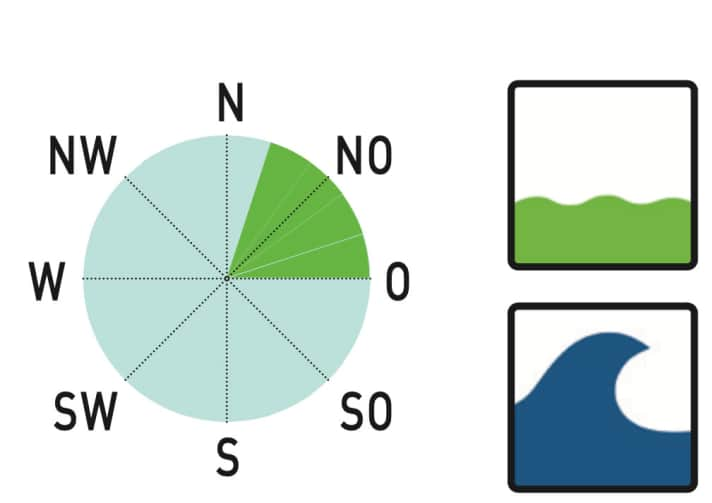
5. Santa Marta - Aéropuerto - 11°07'33.5 "N 74°13'59.8 "W
The spots near Santa Marta are more urban again and much more user-friendly with easy access. We windsurfed at a spot right by the local airport, as the wind on all the other city beaches was offshore and very gusty. Here the wind comes sideshore to slightly sideoff from the right and blows a little more moderately compared to Salamanca. The spot is divided into two parts by a rocky headland that you shouldn't get too close to: To the right of it there is nice chop and a small shore break to play with, to the left of it a bay with smooth water - freestyle wave at its best. Plus a beautiful, urban ambience. The view of the Sierra Nevada de Santa Marta with its green hills and the aeroplanes taking off in front of it is also unique.
TipIf there is no wind in the morning, you can go on a trip to the mountains and then go windsurfing in the evening.
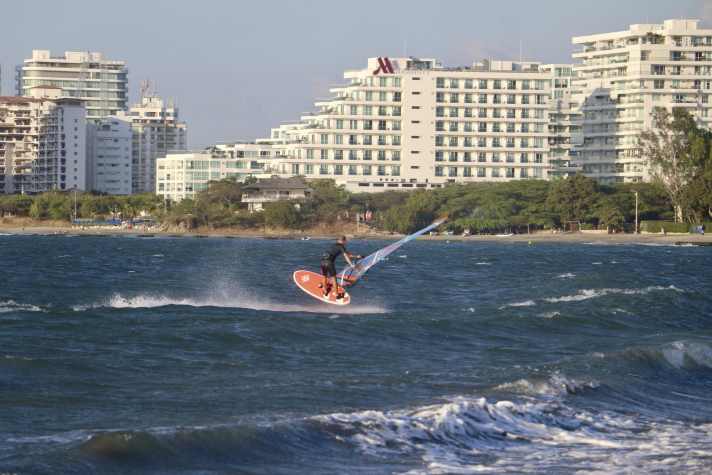
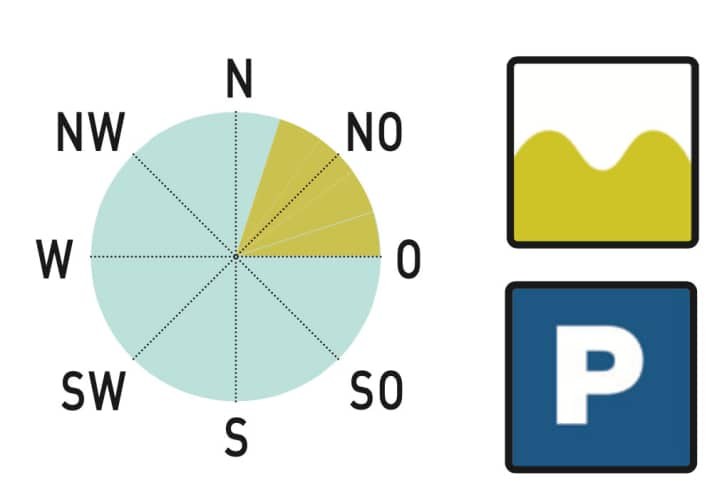
6. Cabo de la Vela - 12°12'14.1 "N 72°09'02.8 "W
This spot is exposed and remote on a large peninsula that juts out into the Caribbean Sea in north-east Colombia. It is close to the border with Venezuela. The wind season lasts until June, with some even talking about wind in July and August. The landscape appears barren, desert-like and is sacred to the Guajira Indians, which has not stopped the Danish company Vestas from installing a large wind farm here. This signals constant wind, which makes electricity generation economically viable. However, the spot in Cabo de la Vela is rather unspectacular for windsurfers. Where the water surface remains smooth, it is too covered for the windsurfing sail and, of course, this is exactly where the kite-flying friends prefer to perform their tricks. Unfortunately, it's a very gusty spot. Further out, a bumpy piste of chop in quick succession awaits, but with a much more constant wind. Accommodation is available in wooden huts right on the beach.
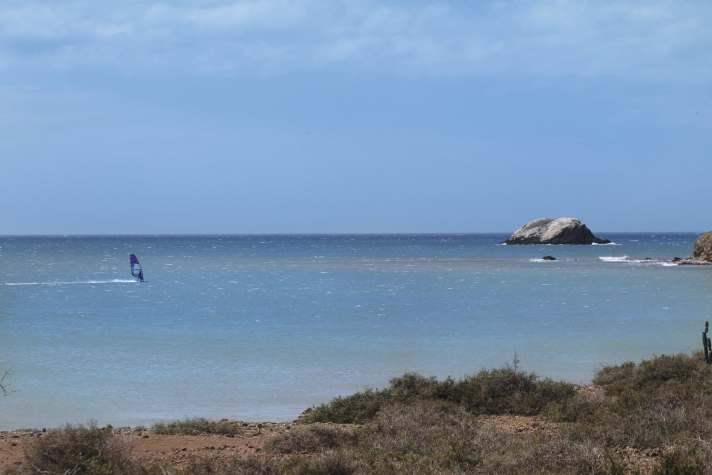
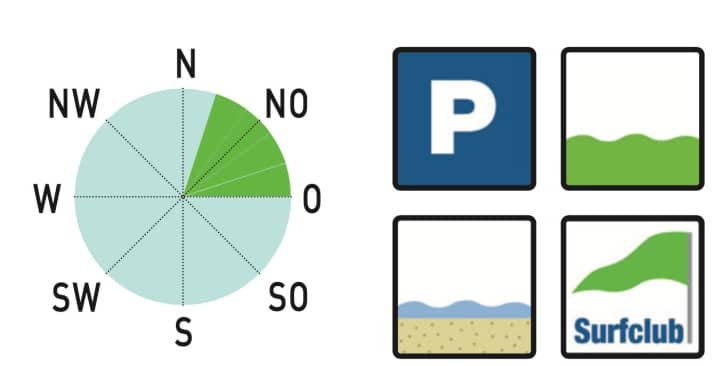
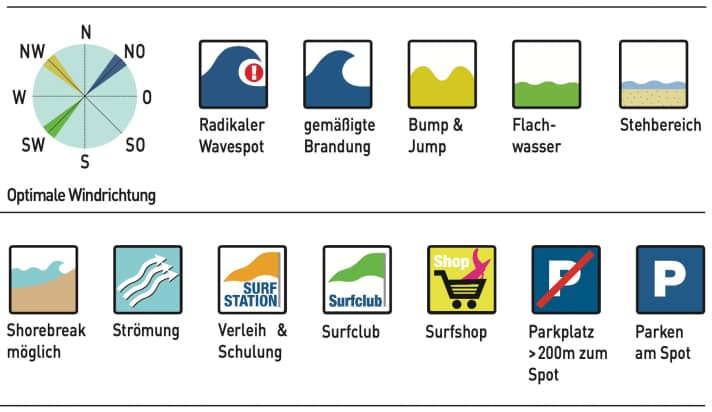
Spot Info Colombia
Arrival
Flights via Bogota to Cartagena are available with KLM from Amsterdam Schiphol, for example, which we found to be the quickest and most convenient. It is essential to obtain official confirmation from the airline when taking material with you. Despite this, we had a 30-minute discussion in broken Spanish with the lady at the check-in desk on the way back. There are numerous alternatives with a stopover in the USA, but they take longer.
Wind, weather and neoprene tips
Colombia lies entirely in the tropics. The equator runs around 500 kilometres south of the capital Bogotá. Here, windsurfing in shorts with lycra or at most a shorty in the evening is the order of the day - the Caribbean Sea and the tropical sun are a delight for cold-stricken northern Europeans. At no time did we find the climate too hot. For those who like it a little cooler, the mountains of the Sierra Nevada de Santa Marta, for example, offer plenty of calming greenery as well as cooler temperatures. The mountain air is a little fresher, but never really cool. The best time to go windsurfing on the Colombian Caribbean coast is definitely the European winter.
The wind season runs from around December to April. In the La Guajira region, where the Cabo de la Vela spot is located, the wind can blow well into June with a bit of luck. However, it is easy to imagine how the wind system on the Colombian Caribbean coast falters with the change of seasons. While it is sunny and clear on the coast, high cumulus clouds pile up on the southern horizon, bringing rain and thunderstorms. The lush green, colourful, blooming landscape in large parts of Colombia is no coincidence. Only the La Guajira region appears much drier, sometimes steppe-like or even desert-like. In general, the weather in Colombia in February seemed very predictable and followed a precise rhythm, which is probably why the wind system seemed so stable. I even stopped checking the forecast during my holiday.
In the winter months, it seems to look the same every day: Sunshine on the Caribbean coast, clouds over the Sierra Nevada and a constant trade wind. In the run-up to the trip, I had prepared myself for rather light winds, thinking of the often mildly fanning trade winds on the ABC islands, where the 5.2 sail is the standard size for many freestylers. But not so on Colombia's Caribbean coast: the wind is strong, somehow wild and warm at the same time.

For whom?
You should have a certain spirit of adventure in your luggage, speak a few words of Spanish and be prepared for the fact that not every day of the trip is predictable. The travel guide I received as a gift says "Handbook for individual discovery". I think this is exactly the right approach if you really want to experience Colombia. The country offers so many possibilities that everyone can find something that suits them. As far as the windsurfing infrastructure is concerned, it is sparse or non-existent. Spare parts should definitely be brought along. Many spots are located away from the cities and it can be really difficult to get a replacement if equipment breaks.
Accommodation and car hire
We usually booked spontaneously and always found reasonable accommodation. The price-performance ratio is very reasonable. When hiring a car, be sure to book an SUV with ground clearance and clean it thoroughly before returning it.
Currency
The cost of living is very low. 50,000 Colombian pesos is equivalent to around ten euros.
Surf schools
- Windspot: Surf school at the spot La V in Bocagrande
- Kite and windsurfing school Windsurfing Columbiawhich mainly trains in Cabo de la Vela, but is based in Riohacha.
- Kite and windsurfing school Mokana Club in Cartagena
Doldrums programme
A visit to the mountain village of Minca in the Sierra Nevada de Santa Marta offers plenty of greenery and a natural contrast to the hectic city life, so you can really switch off here. After the days in the dusty, windy Cabo de la Vela, the jungle was like an oasis of calm. The tours through the forest lead past waterfalls. Away from the main attractions, you will find space for inner contemplation and reflection.
Adventurers with even more time in their luggage should not miss Ciudad Perdida, the lost jungle city, which is located even higher up in the mountains. Unfortunately, it is not possible to climb the Pico Cristóbal Colón, which at 5775 metres towers over the highest coastal mountain range in the world, without a permit. The Tayrona National Park charges an entrance fee, but offers tropical beaches and forests reminiscent of "Avatar" films.
The carnival in Barranquilla is an attraction that has retained its natural charm. As a gringo, you sometimes don't understand what's going on. Why is everyone throwing cornflour at each other? But you don't have to! Just go with the flow, don't wear the most expensive clothes and watch out for valuables.

